3270 Help for Employee ID
Overview
Current, past, future and potential University employees
as well as affiliates are uniquely identified
within BASIS by a six digit numeric identifier known as the Employee ID.
 The common label on screens for this field is Emp ID:,
as shown in the accompanying screen snapshot from the PSB menu.
When the value of the Employee ID for an individual is not known,
just press PF1 while the cursor is within this input field.
This invokes the Employee ID help facility described here, which allows you
to search the BASIS data base in order to find the employee ID
you are seeking, select it, and return that value to the input field where
PF1 was pressed.
The common label on screens for this field is Emp ID:,
as shown in the accompanying screen snapshot from the PSB menu.
When the value of the Employee ID for an individual is not known,
just press PF1 while the cursor is within this input field.
This invokes the Employee ID help facility described here, which allows you
to search the BASIS data base in order to find the employee ID
you are seeking, select it, and return that value to the input field where
PF1 was pressed.
Note: The BASIS Emp ID should not be confused with the unique identifier
of students, employees, and affiliates within ISIS.
This ISIS identifier is also named Employee ID but is nine digits long.
It is also
referred to as: University ID, Empl ID, Person ID, and P ID.
 (If you know the ISIS identifier of a BASIS employee, you can enter it into the
BASIS Emp ID field prefixed with a P
and BASIS will look it up
and translate your input into the BASIS six digit value – as shown in the
example to the right.)
(If you know the ISIS identifier of a BASIS employee, you can enter it into the
BASIS Emp ID field prefixed with a P
and BASIS will look it up
and translate your input into the BASIS six digit value – as shown in the
example to the right.)
Further, please realize that BASIS maintains several names for an employee.
Every employee has an official, legal, W4 name.
In addition, employees may specify a preferred first/middle name
that they commonly use or are known by.
BASIS also retain employee former names whenever there
is a change to their legal name.
And last, if the employee's last name has a common suffix like Jr.,
II, III, etc.
BASIS will maintain a version of their name without this suffix so that
the suffix does not have to be known in order to find the employee via the
name search (when a first name is also specified).
And since multiple names are maintained, the same employee
may be listed multiple times (once for each name) when performing name searches.
The following sections provide additional information about the
Employee ID Help facility.
Search Window
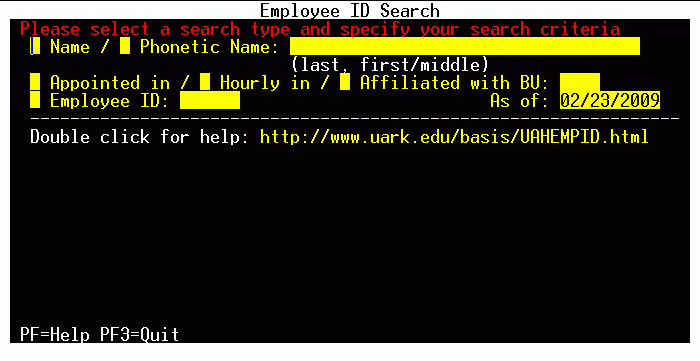
The example above is of the initial search window presented in
the bottom right of your 3270 screen
(when a Quick Name Search
has not been used).
Here you must select one of the six possible search types and search
values as described in the following section.
(If you are using QWS3270 and you double click the url
http://www.uark.edu/basis/UAHEMPID.html,
this help page will open in your web browser.)
Search Types
You may browse employees six different ways:
- by name,
- by phonetic name,
- appointed employees for a budgetary unit as of a date,
- current hourly employees for a budgetary unit,
- affiliates for a budgetary unit as of a date, or
- just by Employee ID.
You must select only one search type by entering any non-blank
character in any one of the input fields preceding each of these types
as shown in the following examples.
You must also specify a corresponding starting search value –
name, BU, date, or Employee ID – as shown in the corresponding examples.
Simple Name Search

This snapshot shows performing a simple name search (X
indicates the Name
search type is selected) for last name TREE and first name BERRY.
(Searches are not case sensitive and search values are always
capitalized by the system.)
From the list of names you can see that BASIS stores employee names as
last name, comma, space, first name, slash, and any optional middle name.
If you are specifying starting first and middle names you must follow this
same convention.
In general it is better to specify a subset of the name and then scroll forward
and backward as needed to locate the desired employee.
Along with the name and Emp ID, the display shows the current status of the
employee (as of today) and associated Budgetary Unit:
appointed,
hourly (+ indicates working in multiple BUs),
affiliate,
not employed nor an affiliate,
or deceased.
Phonetic Name Search
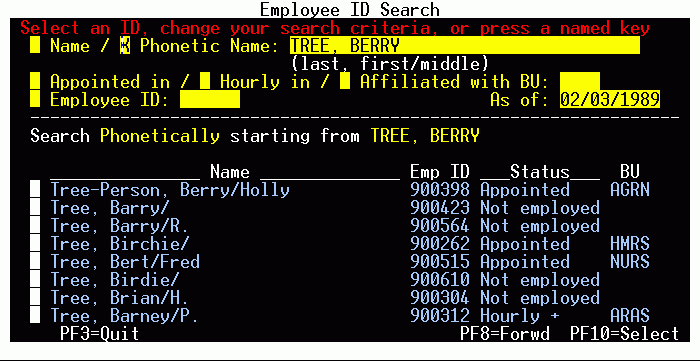
This snapshot shows performing a phonetic name search (X
indicates the Phonetic Name
search type is selected) for last name TREE and first name BERRY.
Phonetic searches use an algorithm to group names that may sound alike even
when spelled differently.
It is not perfect, but it can be of assistance when an employee cannot be
located with a simple name search.
Only last name and an optional first name need to be specified.
(If an employee has a middle name and only an initial specified for first
name then the middle name is used in the phonetic search.)
The same status and BU information is displayed as for a simple name search.
Appointed Employee Search
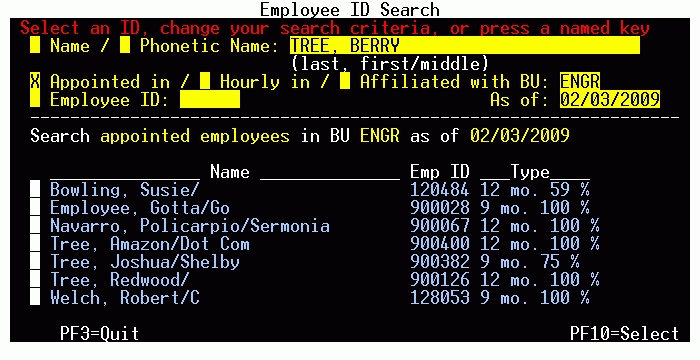
This snapshot shows performing an appointed employee search (X
indicates the Appointed in
search type is selected) for Budgetary Unit ENGR
as of 02/03/2009.
All employees for the BU and date are available basically in alphabetic
sequence.
A name will be out of order if a recent name change has been made.
Rather than status, the type of employee (9 or 12 month appointment) and
appointment percent is displayed.
Hourly Employee Search
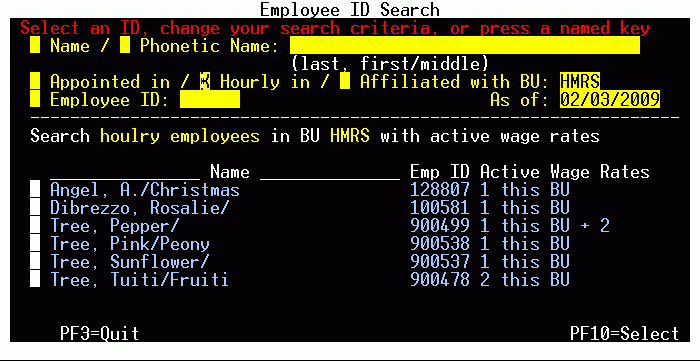
This snapshot shows performing an hourly employee search (X
indicates the Hourly in
search type is selected) for Budgetary Unit HMRS.
All employees with active wage rates for the BU are available basically in alphabetic
sequence.
A name will be out of order if a recent name change has been made.
This list displays how many wage rates the employee has in the specified BU
plus a count of the number of active wage rates the employee has in other BUs.
Affiliate Search
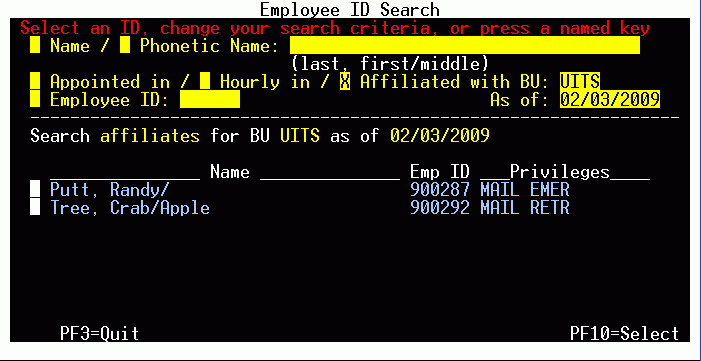
This snapshot shows performing an affiliate search (X
indicates the Affiliated with
search type is selected) for Budgetary Unit UITS
as of 02/03/2009.
All affiliates for the BU as of the specified date are available basically in alphabetic
sequence.
A name will be out of order if a recent name change has been made.
This list displays some of the privileges that have been granted
to the affiliate.
Employee ID Search

This snapshot shows performing an employee ID search (X
indicates the Employee ID
search type is selected) starting from Employee ID 900100.
Employees and their status are displayed in Employee ID sequence.
Quick Selection
Once one or more employees are listed, PF10 will be labeled Select.
You may mark or merely place the cursor on the line of a desired employee and press PF10
to have that Employee ID returned to the input field from where
you requested help.
Or, you may obtain additional information about one or more employees listed
as described in the following section.
Status and Name Detail Window

You may select one or more employees from the list and press Enter.
This will display the Status & Name Detail window within
the main search window, as shown above.
Here you may view all of the employee's names (preferred, legal, former and suffix-less),
additional current status information, gender, and work address and phone number.
Pressing Enter from within this window (or marking Enter=Q/Nxt)
will present the next employee selected.
Pressing PF3 will close this window and return you to the main search window.
And pressing PF10 (or marking PF10=Select this Emp)
will select the displayed Employee ID and return that value
to the input field from where you requested help.
If you enter a social security number in the Verify identity via SSN
field you will receive a message indicating whether the SSN entered matches
or does not match the selected employee.
In this way, if you know the employee's SSN for which you are searching, you
can verify that this is the desired employee and Emp ID.
Quick Name Search

You may save a step by entering a simple name search value into the
Emp ID field before pressing PF1, as shown in this example.
This will invoke the help routine and initiate a simple name search using
this value as shown below.

 The common label on screens for this field is Emp ID:,
as shown in the accompanying screen snapshot from the PSB menu.
When the value of the Employee ID for an individual is not known,
just press PF1 while the cursor is within this input field.
This invokes the Employee ID help facility described here, which allows you
to search the BASIS data base in order to find the employee ID
you are seeking, select it, and return that value to the input field where
PF1 was pressed.
The common label on screens for this field is Emp ID:,
as shown in the accompanying screen snapshot from the PSB menu.
When the value of the Employee ID for an individual is not known,
just press PF1 while the cursor is within this input field.
This invokes the Employee ID help facility described here, which allows you
to search the BASIS data base in order to find the employee ID
you are seeking, select it, and return that value to the input field where
PF1 was pressed.
 (If you know the ISIS identifier of a BASIS employee, you can enter it into the
BASIS Emp ID field prefixed with a P
and BASIS will look it up
and translate your input into the BASIS six digit value – as shown in the
example to the right.)
(If you know the ISIS identifier of a BASIS employee, you can enter it into the
BASIS Emp ID field prefixed with a P
and BASIS will look it up
and translate your input into the BASIS six digit value – as shown in the
example to the right.)









